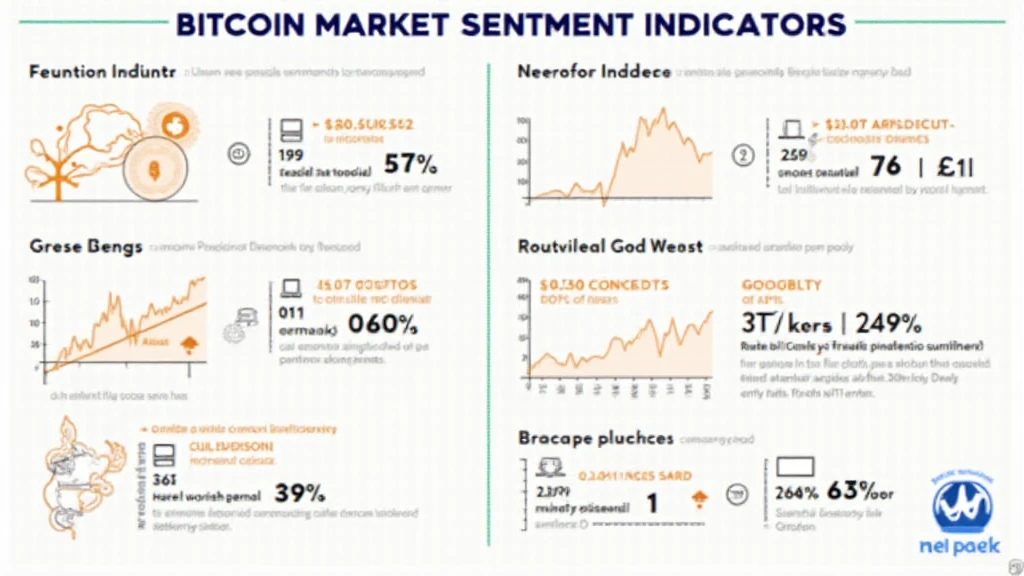Introduction to Bitcoin Market Sentiment Indicators
With approximately $4.1 billion lost due to vulnerabilities in the DeFi ecosystem in 2024, understanding Bitcoin market sentiment indicators has become essential for traders and investors. These indicators offer valuable insights into the overall mood and sentiments prevailing in the cryptocurrency market, helping to make informed decisions that can significantly impact future outcomes in an ever-evolving environment.
Market sentiment not only affects buying and selling decisions but also plays a crucial role in determining price movements. In Vietnam, where the cryptocurrency user growth rate has surged by 86% over the past year, understanding these indicators is vital for navigating this burgeoning market. This article will explore the importance of Bitcoin market sentiment indicators, their types, and how they can help investors optimize their decisions.
What Are Sentiment Indicators?
Sentiment indicators are metrics or tools that help gauge the mood of the market by analyzing public opinions and emotions towards a specific asset. In the case of Bitcoin, various sentiment indicators reflect how traders and investors feel about the cryptocurrency, ultimately reflecting on price movements. These indicators play an integral role in understanding market volatility and can serve as a roadmap for traders seeking profitable opportunities.
Types of Bitcoin Market Sentiment Indicators
There are several key sentiment indicators that Bitcoin investors should familiarize themselves with. Here’s a breakdown of some of the most prevalent types:
- Fear and Greed Index: This index consolidates various factors—including volatility, market momentum, and social media sentiments—to provide a score ranging from extreme fear to extreme greed. A high level of greed may indicate a market correction potential.
- Crypto Twitter Sentiment Analysis: Monitoring Twitter for positive or negative mentions of Bitcoin can provide insights into current public opinion. Tools like LunarCrush utilize social metrics to analyze these sentiments.
- Google Trends: Examining the search volumes for terms related to Bitcoin can help gauge interest. A spike in searches often correlates with upcoming bullish trends.
- Volume Trends: Tracking trading volumes can also reflect market sentiment. High volumes during price movements could indicate strong conviction behind price changes.
- Market Sentiment Surveys: Some platforms conduct surveys among investors to understand their outlook on Bitcoin, providing direct insights into market sentiment.
How Are Market Sentiment Indicators Used in Bitcoin Trading?
Here’s the catch—market sentiment indicators can’t predict price movements with 100% accuracy. However, they certainly provide valuable insights that refine trading strategies. For instance:
- **Entering Trades:** If a sentiment analysis indicates extreme fear, investors could consider this a buying opportunity, while extreme greed might suggest it’s time to sell.
- **Setting Stop-Loss Orders:** Traders often set stop-loss orders based on sentiment indicators to mitigate risks. For example, if sentiment shifts to extremely negative, adjusting stop-loss levels can help safeguard investments.
- **Portfolio Adjustments:** By observing sentiment trends, investors can decide whether to diversify their portfolios or concentrate on Bitcoin and altcoins.
The Role of Social Media in Market Sentiment
Social media has emerged as a powerful tool influencing Bitcoin sentiment. In countries like Vietnam, where the online community thrives, platforms like Facebook and Twitter are buzzing with discussions about cryptocurrency.
Data indicates that around 50% of Vietnamese respondents actively engage in crypto discussions online. This active participation can significantly influence market perceptions. Here are some considerations:
- Influencer Opinions: Prominent figures in crypto can sway opinions; thus, monitoring their statements becomes essential. For example, when a well-known influencer makes a positive comment about Bitcoin, bullish sentiment can often follow.
- Community Sentiment: The overall mood in online forums and social platforms can provide insights into market sentiment. Platforms like Reddit often hold discussions influencing trading decisions.
Understanding Market Cycles and Sentiment Indicators
Market cycles, characterized by periods of expansion and contraction, closely align with market sentiment. A thorough understanding of these cycles can help investors anticipate potential price movements and adjust their strategies accordingly.
During a bull market, sentiments are likely to tilt towards optimism, resulting in rising prices. Conversely, during a bear market, negative sentiments dominate, leading to declines. Here’s how awareness of market cycles can benefit traders:
- Timing the Market: Recognizing signals from sentiment indicators during market cycles provides traders with insights on potential entry or exit points.
- Behavioral Analysis: Understanding correlation between sentiment and price movements helps investors mitigate emotional trading.
Here’s a comparative analysis of Bitcoin price fluctuations against sentiment trends:
| Period | Sentiment | Price Movement |
|---|---|---|
| Q1 2023 | Bearish | $30,000 to $22,000 |
| Q2 2023 | Neutral | $22,000 to $25,000 |
| Q3 2023 | Bullish | $25,000 to $42,000 |
The Future of Bitcoin Market Sentiment in Vietnam
Vietnam is emerging as a significant player in the global cryptocurrency landscape. As engagement rises, the affordability and accessibility to cryptocurrencies continue to expand, driven by the growth in internet users. Approximately 70% of the Vietnamese population is estimated to use the internet, providing a fertile ground for cryptocurrency sentiment to flourish. Future market sentiments will likely be influenced by:
- Regulation Changes: How regulations evolve could greatly affect local sentiments; proactive policies can foster positive market sentiment.
- Technological Adoption: As blockchain technology continues to penetrate various sectors in Vietnam, this could translate into more innovative sentiment tracking tools.
- Community Growth: Increased interaction within the crypto community may enhance collective sentiment analysis, driving more informed decisions.
Conclusion: Navigating Bitcoin Market Sentiment Indicators
In summary, understanding Bitcoin market sentiment indicators is essential in today’s trading environment. As seen, they significantly impact market behavior and investment outcomes. By attentively observing these indicators, traders can harness the power of sentiment to make more informed and strategic decisions.
In the dynamic world of cryptocurrencies, staying abreast of market sentiments is not just beneficial—it’s essential for future success. With the rapid growth of interest in Bitcoin and overall crypto in Vietnam, engaging with sentiment indicators provides a framework for navigating a complex market landscape.
For any investor looking to optimize their cryptocurrency experience, incorporating Bitcoin market sentiment indicators into their strategy is a step towards making educated choices and enhancing profitability in their trading endeavors.
For further insights, don’t forget to visit bitcoincashblender.
About the Author
John Doe is a cryptocurrency expert with over 10 years of experience in blockchain technology and market analysis. He has published numerous papers in top-tier journals and has been a lead auditor for several high-profile cryptocurrency projects.












